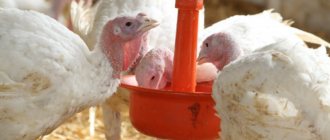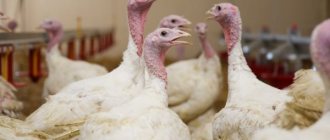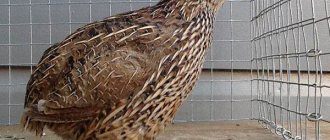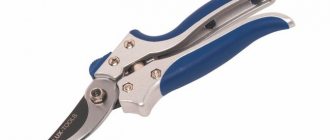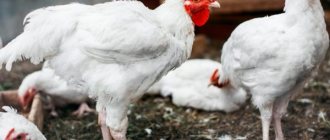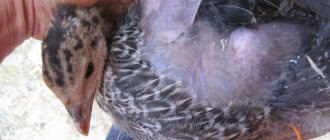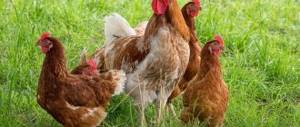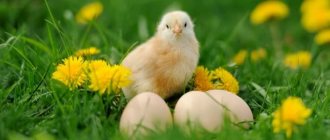Turkey plumage
Birds have thick plumage of various shades. There are white breeds, marbled and brindle, gray or speckled. Whatever color the plumage of turkeys is, its main value is its high thermal insulation properties.
The downy covering of a turkey is shiny, and despite the general health of the bird, it is elastic. Where is the down of these exotic poultry used, and what is its main value? First of all, down and feathers retain heat well.
Therefore, it is widely used in the textile industry. Turkey feather can be found as a filler in sleeping bags for tourism and hiking, down outerwear, pillows and blankets.
Preventing fights in turkeys
Compliance with veterinary and zootechnical standards will help to avoid aggression in the herd. It is necessary to monitor poultry for the presence of lice eaters, intestinal helminths, and prevent diarrhea.
To prevent feather plucking and cannibalism in young animals, it is recommended to stretch a wire over the feeder, on which the turkey poults will clean their beaks after feeding.
It is recommended that breeding turkeys have their claws trimmed to prevent them from injuring the female during mating. Measures to reduce overall injury also reduce the likelihood of pecking in the herd.
- Related Posts
- Turkeys at 3 months
- What to feed turkeys
- How to clip turkeys' wings so they don't fly
- Turkeys sneeze, what to treat?
- Turkeys big 6
- Proper feed for turkeys
At-risk groups
When studying the issue of plumage loss, special attention should be paid to caring for birds at risk. The following categories of birds are especially affected by the disease:
- Turkeys under three months of age. It is this age that is considered the most vulnerable; during this period they can be susceptible to various viral diseases that undermine the immune system. It is because of weakened immunity that birds can lose feathers in large numbers. You should pay close attention to the health of your birds and give them the necessary vaccines within a few weeks of birth. A good prevention would be to include complex vitamins and microelements in the diet.
- Females are more susceptible to baldness. If laying turkeys begin to peck at their own fluff, then baldness in hens becomes noticeable to a greater extent than in males. What is the reason for this visual effect? The answer is quite simple. The fact is that male birds have multi-level plumage. When bald spots appear, bare areas of the body become less noticeable.
About
Preventive actions
Knowledge of the characteristics of turkey breeding allows you to take timely and effective measures to prevent manifestations of cannibalism, which sometimes have such dire consequences as prolapse of an inflamed cloaca.
To prevent the chicks from inflicting injuries on each other, which in especially severe cases can even cause the cloaca to fall out after pecking, their beaks are cut off. This procedure is called debeaking and is carried out with special tools.
The greatest success in further rearing can be achieved if the beak is trimmed at one day of age. Depending on the specific conditions, the availability of a specialist and the necessary tools, it is possible to de-beak turkey poults that have reached the age of seven days and even one-month-old young animals.
Allows you to eliminate the causes of aggressiveness, expressed in the fact that turkey poults constantly peck not only their own body parts, but also inflict wounds on each other, with a well-balanced diet. Chicks require fiber, so crushed grain is added to the feed mixture.
Among the recommendations of veterinarians, there is advice that the introduction of oats, table salt, and cake into the feed will help prevent turkey poults from pecking each other. Good results are achieved by using a highly concentrated protein food product - meal.
Considering that lighting often becomes a motivating force for chicks to start pecking at the cesspool of laying hens, you should consider installing lamps in the poultry house that provide dim white or bluish light.
An abrasive mixture should always be available, which can be poured into a separate feeder or added to the feed. When pecking, the chicks gradually wear off their beaks, which reduces the degree of injury if pecking does occur.
Why do birds pluck their feathers?
The reasons why turkeys begin to pinch and pull at themselves or other individuals are an unbalanced diet, stress and aggressive behavior. Let's look at each case in more detail.
- Unbalanced diet. The most common reason why female and male turkeys peck their feathers is that the birds' diet is unbalanced and they do not receive additional nutrients.
- Poor living conditions. Turkeys are quite finicky by nature. They require the organization of comfortable living conditions for themselves. Due to the large size of many broiler breeds, farmers have to build fairly spacious poultry houses and aviaries for walking. If the poultry house is dirty and the room is not disinfected and cleaned in a timely manner, the turkeys may get sick. Loss of plumage is in this case a consequence of the disease. To ensure that the hen and the male feel good and do not lose their feathers, read the recommendations for building and arranging a barn for birds.
- Lack of nutrition. It is important that the birds receive enough food. Otherwise, they will not receive the required ratio of fats, proteins and carbohydrates. Females and young birds suffer the most from this. In terms of physical strength, they are inferior to males, who are more aggressive and can push weaker individuals away from the feeder. Systematic malnutrition leads to loss of feathers, pecking at each other or themselves. They begin to feel unwell and may die in severe cases.
- Stress is one of the main factors that can cause birds to pluck their own or other individuals' feathers. In nervous individuals, the creation of a stressful situation can be caused by moving to another place, climate change or sudden cold snap. Stress is also caused by replacing the usual diet with a new one and building new perches. Many laying hens even stop laying eggs, lose their down, and develop bald patches.
- Aggressive behavior during the mating season. Mating of individuals in order to produce new offspring occurs annually in turkeys. Males behave extremely aggressively during this period of the year. This is due to the fact that the right to mate must be won.
About
Treatment and behavior correction of turkeys
If individuals with plucked feathers or with lacerations on the body are found in the flock, then it is necessary to remove the injured, pecked birds to a separate pen. Provide them with comfortable living conditions. If their feathers are plucked and muscle tissue and skin are damaged, then they resort to certain therapy:
- wounds are treated with an antiseptic. To do this, it is better to keep hydrogen peroxide, potassium permanganate, Furacilin or Miramistin in the first aid kit;
- After disinfection, the wounds are lubricated with healing ointments. Use "Levomikol", "Iruxovetin" or "Streptocidal ointment";
- to reduce stress in birds and increase immunity, feed birds with a 2% solution of glucose or ascorbic acid;
- Infection can enter the body through wounds. Birds are given antibiotics as a preventive measure against infectious diseases. Choose a broad-spectrum drug. This could be Baytril, Erythromycin, Furazolidone;
- the rest of the herd is given mineral supplements in the feed;
- It is recommended to add feather meal to the diet, 4 g per head;
- good results are observed when methionine or manganese sulfate is introduced into the feed; 20 mg per head;
- for cannibalism for birds, sulfur is added to the grain mixture; 2 g per head;
- birds are given potassium iodide, 3 mg per head. This product is a good antiseptic; prevents the development of infection in the body;
- chalk, crushed shells, and egg shells are added to the food; 1 g per head for young animals, up to 6 g per head for adults;
- Herbal flour, juicy grass, vegetables and root vegetables are introduced into the diet. It is recommended to replace traditional food with combined food for 2 weeks. It will provide the birds with a complete diet.
More on the topic: What grass do turkeys eat?
Pecking most often occurs in winter. In the summer, being on a free range, no changes in the behavior of the birds are observed. In winter, individuals may receive insufficient amounts of mineral salts and vitamins. They develop various types of vitamin deficiencies. It is necessary to carry out preventive measures to prevent pecking in the herd.
Main reasons
There are a number of reasons why turkeys peck each other until they bleed. What to do in this case, each farmer decides independently, based on personal experience and knowledge. Most often, pecking to blood occurs due to changes in the conditions of detention. Diet adjustments may also be the cause.
Many poultry farmers find wounds in their chicks in the cloaca area. Why is this happening? This happens when the functioning of the gastrointestinal tract is disrupted. Or this is a consequence of severe contamination of the surface of the plumage.
The kids begin to peck at the turkey chick that has just been placed with them. In this case, experts advise not to place birds of different ages and not to keep them together, otherwise the older ones will peck at the younger ones.
In addition, when birds lay eggs, the bleeding anus attracts chicks. It is strictly not recommended to create additional lighting for laying hens.
Another cause of pecking in turkey poults is a deficiency or excess of protein. Cracks form in the skin around the anus, as a result the chick begins to peck at itself.
If the air in the poultry house is too dry, the baby's coccygeal gland is sharply compressed. Another reason why turkey poults peck at each other’s cloaca is skin parasites. Factors such as injuries, insufficient and untimely cleaning of the poultry house, dampness, and excessive crowding play a role here.
As you can see, there are no answers to the question “Why do turkey poults peck at each other?” quite a bit of. But as a rule, the sources of such an unpleasant symptom in small chicks are those individuals who have diseases of the anus.
How to deal with biting
If signs of cannibalism appear among the livestock, then it is necessary to urgently take measures to eliminate its causes. The fact is that such behavior can become a habit and it will be unrealistic to wean such turkeys.
Recommendations to help cope with the problem of pecking
The reason why little turkey poults peck at each other lies in the improper keeping of the birds. In order to avoid problems, it is recommended:
- Maintain optimal temperature. This is important, since the chicks are not yet able to independently regulate their body temperature. In the first week of life, the temperature should be 36-37⁰ C. A higher temperature leads to dry air and the need for increased work of the coccygeal gland, a low temperature causes babies to huddle together. In both of these cases, things end in disaster. It is also necessary to ventilate the room where the chicks are kept.
- Normalize your diet. In most cases, this helps control cannibalism among poultry. The daily protein requirement for turkey poults aged 1-4 weeks is 26-28 grams, and by 4.5 months it is reduced to 14 grams. Failure to comply with these proportions entails the development of acidosis, accompanied by weakening of the anal muscles. The chicks begin to peck at the affected cesspool.
- Create optimal groups of birds of the same age so that the stronger chicks do not peck the weaker ones.
- Dim the lighting. This will prevent the cubs from seeing the cloaca and the presence of blood in the female, and thereby reduces the risk of problems.
- Replenish the lack of minerals. If turkeys do not have enough trace elements and minerals in their diet, they are very likely to start pecking and plucking feathers from their sisters and brothers.
- Removal of wounded individuals. They must be immediately removed from the flock so as not to provoke a surge in cannibalism.
- Organize free range. It helps to cope with birds pecking each other until they bleed. Walking with the opportunity to dig the ground and nibble grass significantly reduces the risk of cannibalism. Walking allows the chicks to be distracted by more interesting things.
- Parasitic infestations also often lead to problems with cloacal pecking. If birds are sick with lice, they will pluck the feathers of themselves and those around them. It is necessary to take measures to treat turkey poults for parasites.
Treatment of wounded turkey poults
Birds with minor injuries should be isolated and treated. Wounds must be treated with an antiseptic. Some poultry farmers advise using the ASD-2 product, which not only disinfects and heals pecked areas, but also repels other young birds from them.
To treat victims of cannibalism, it is possible to give birds methionine, arginine and cystine in combination with various bromide drugs along with food. To form and restore feathers, iron, manganese and copper sulfates, sodium selenite and cobalt chloride are introduced into the diet of turkeys.
Pecking can occur at any age. In turkey poults, it occurs when down gives way to feathers. During this period, weak young animals must be kept separately so that they are not pecked.
Birds' diet must be properly balanced and enriched with vitamin and mineral supplements.
Causes of pecking
It is impossible to unequivocally answer why turkey poults peck each other until they bleed. There are quite a few reasons and they all have completely different origins. Cannibalism most often begins with pecking of eggs, then the bird switches to itself or weaker chicks.
In order to stop pecking in domestic turkeys, it is necessary to find out its Cause. Most often, turkey poults peck at each other due to:
- Digestive problems. They provoke diarrhea in the turkey and contamination of the feathers in the anal area. This attracts its other brothers and leads to pecking.
- Too bright lighting gives the chicks the opportunity to see the bleeding cloaca of the brood turkey. During the period of egg laying, the cloaca experiences constant tension and can crack and bleed.
- Manifestations of hierarchy in a flock. If you introduce a new turkey chick, the others begin to peck at its head and wings. It is for this reason that it is recommended to form groups of chicks by age.
- A weak or sickly turkey poult also encourages cannibalism. Stronger individuals attack the chick and peck it.
- Lack of nutrition or contaminated food and water. Trying to make up for the lack of nutrients, the birds peck everyone they come across. As a result, almost all the chicks of this group remain injured.
- Too crowded content leads to the same result.
But in addition to cannibalism among the turkey population, it often happens that turkey poults begin to peck at themselves. As a result, the sight of blood attracts other brothers. Turkey poults peck themselves due to an excess or lack of protein in the diet. This causes small cracks to form around the anus, causing the bird pain and discomfort and causing it to harm itself.
Another common reason for turkey poults pecking is excessive dryness of the environment. They have to strain the coccygeal gland to secrete secretions and lubricate the feathers with it. This causes unpleasant sensations, and the turkey chick begins to peck at itself.

